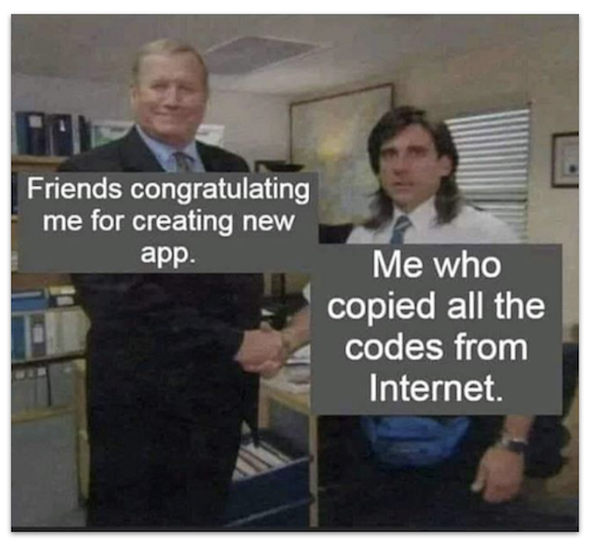OPED ― Our Unvarnished Opinion
This week as I was working on some updates for my upcoming 6 Pack Apps course, I was talking to a business owner friend of mine about app design. Specifically about app design prototypes and she had no idea what an app design prototype was or what it was used for. Then I realized that whole “curse of knowledge” thing had struck again. Maybe I should talk to y’all about it?
It all starts with the user experience of your app design. How it works. Is it obvious? Can people find things like… the text? …the buttons? Is it easy to navigate? You can test your user experience design with an app design prototype, which is a non-functional mock-up of your app. It can be as simple as a few rough sketches that you scribble on a napkin and you can take pictures of those rough sketches and load them up in a free prototype tool like Marvel app or Prototype on Paper (POP), Invision app or Adobe XD.
In the prototype tool, you connect up all the buttons and navigation so that it moves from screen to screen when people tap on those parts of the app. In this way you can test how your app works with a real user. At this stage of your app, failure is very low cost, if your app design doesn’t work very well. You can simply go back to tweak a few things in the prototype, or scribble a different screen design and test again. It’s very cheap and very easy to update. But if you don’t create a prototype and test it…. if you find user experience issues after the app is already fully developed, it can cost you a LOT to go back and fix.
So… app design prototypes… do you use them?
― WNDXLori
FITS ― Featured in the School
As I mentioned in our last newsletter, we hit 500 subscribers (actually 530 now 🎉). And we celebrated by having a prize draw for the RubyMotion Jumpstart course from among our new subscribers. Congratulations to Brian Cunnane, our lucky winner!
This week, we’ll continue the celebration with free copy of RubyMotion Query In Depth. Although it’s no longer possible to purchase this set individually, it will be part of our upcoming re-release of the MotionInMotion videos as a subscription (stay tuned!!). All newsletter subscribers - as of this morning - will be thrown into the hat for this draw, and we’ll make that winner announcement next time!
Thanks to all of you, our valued community, for making this newsletter a success!
COMM ― Community
As North America enters its sixth week of the corona virus lockdown, some interesting accounts are beginning to emerge from those companies which, without any notice whatsoever, have had to transform themselves into 100% virtual, work-from-home (WFH) organizations. One of the most thorough reviews we have come across is the three part series from Canadian software success story Clio.

Like many organizations, Clio went from more-or-less business as usual on Friday, the 13th of March, to completely WFH the following Monday. As Clio is in a rapid growth phase, they had new hires who started on precisely Day 1 of the lockdown. From three different perspectives―the new hires themselves, their managers and the onboarding team―the article describes the transmogrification of their business processes to meet the newly minted remote onboarding requirements.
All three parts of the article are worthy of your time. One thing we are left wondering, though: in the article there is apparently an underlying assumption that WFH for Clio is a tactical response to a tactical problem. When this is all over, everybody will head back into the office. By that time, however, and with staff and processes adapted so successfully to the ‘new normal’, will some Clions want to continue WFH even after the return-to-office edict comes down?
What do you think? Will the temporary need to WFH put pressure on for permanent WFH for some companies like Clio?
AHTW ― App Highlight This Week
Those readers with school age children have a lot more on their plate than those of us who are simply trying to adjust to WFH ourselves. School-from-home (SFH?) means creating a meaningful curriculum which meets educational needs and yet keeps stir-crazy, cabin-fever kids engaged. Here’s a suggestion: for the computer science class (you are going to have one of those, right?) create a game for your budding Katherine Johnson. Better yet, create it with them. Morgan Schweers has what you need to get a headstart with his version of Tic Tac Toe written in, what else, RubyMotion!
DRGTK ― DragonRuby Game Toolkit

What does French carmaker Renault have in common with game development? Bézier curves, of course! Actually, we didn’t know that either, but one never knows what Wikipedia is going to reveal, does one? And it’s a great excuse to include this photo of one of our favourite Renaults, the Alpine A310 which has some Bézier curves in its design. Seriously, though, if you want to truly understand Bézier curves, our friend Amir Rajan has just produced a great demo which runs in a browser. We guarantee you’ll understand Béziers better if you just give it a try.
Vive la différence!
DRSH ― Dragon Riders Slack Highlights
We like to regularly remind our readers of another great resource available to them: the perennially chatty Dragon Riders Slack team. It’s always a great place to connect socially while remaining physically distant, as we’re often told to do these days. It’s not only a source of great answers to questions we have: sometimes there are questions for which you may have an answer. For example, Dragon Rider Gustav Fahl asked a question about a flexible gem to provide a “Made with RubyMotion” badge which then links to an About page. We think every app should have one. Have you created such a gem? Care to share?
ANDROID ― Nothin’ but…
Are you normally satisfied to simply have the AlertDialog do its thing and allow you to move on to bigger and better things? Not so fast. There are a ton of tweakable details in AlertDialog which you may not know about. They’re covered in detail in What You Might Not Know About the AlertDialog which appeared recently in the ProAndroidDev publication on Medium. Can you spare four minutes for better alerts?
GOTW ― Gem of the Week
All that home schooling you’re doing may have tested your rather rusty math skills. OK, let’s call them what they actually are: not so much math as it is basic arithmetic. Long division? It’s what happens when you click the divide button, right? If you’re like a lot of us who would just as soon leave the number crunching to someone else, do we have a gem for you: Dimsome is a collection of handy 2D arithmetic methods from Calico Day.
TWIL ― This Week I Learned
Not so much a utility or tool, as usual, but rather a very succinct, well-written, four tweet thread by Russ Shanahan on identifying the core strength of an app. We’re really beginning to like these Twitter threads as a form of mini-essay. 280 characters per idea really challenges the writer to parse their points into compact, clear and digestible chunks.
We really did learn something this week, after all.
HAHA ― And They All Laughed
Ever receive praise that you really didn’t deserve? Happens to us all the time. (image: Universe of Programmers)

That’s a Wrap!
The world’s best DragonRuby newsletter is delivered to you, curbside and contact free, every two weeks. Well, it will be if you subscribe! We’re also on Twitter and Instagram and we really hope you’ll follow us there for content you can’t get anywhere else.
Until next time, stay safe and stay well.